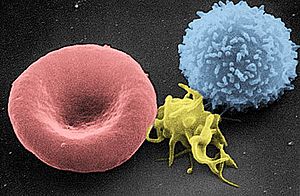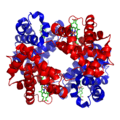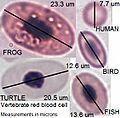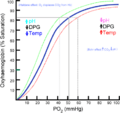Blood facts for kids

Blood is a liquid in humans and many animals except insects. Blood is pushed through the organism by the heart, and brings nutrients and oxygen to our tissues. It also takes away waste and carbon dioxide from tissues.
Blood of vertebrates is made up of blood plasma and various cells — red blood cells, white blood cells and platelets. Platelets help blood to clot. Hemoglobin is in red blood cells. White blood cells help fight infections and heal wounds.
Contents
Plasma
Blood plasma is the yellow liquid in which blood cells float. Plasma is made up of nutrients, electrolytes (salts), gases, non-protein hormones, waste, lipids, and proteins. These proteins are albumin, antibodies (also called immunoglobulins), clotting factors, and protein hormones. Plasma that does not have the protein fibrinogen is called serum and cannot clot. Adults have about 3 liters of plasma. Plasma is a liquid, mostly water (90%). Plasma takes up 55% of volume.
Red blood cells
Another name for red blood cell is erythrocyte. 'Erythro' means red; 'cyte' means cell. RBC is an acronym for red blood cells.
RBCs carry oxygen and carbon dioxide around our body. Cells in our body need oxygen to live. Cells also make carbon dioxide as a waste. RBCs bring oxygen into the body and carbon dioxide out.
RBCs are filled with haemoglobin. This is a protein. It is made to carry a large amount of oxygen. Haemoglobin has iron in it. The iron and oxygen gives haemoglobin its red color. This is why blood is red. Erythropoietin promotes the creation of RBCs. Blood type antigens are carried on the surface of red cells.
RBCs also help the blood stay normal pH. The blood needs a to be at a pH of 7.4. If it is much more or less than 7.4 a person can get very sick or die. RBCs are a buffer for the blood pH. Buffer means that it stops changes in pH. The proteins and the carbon dioxide in the RBC are buffers for the blood. If you do not have enough RBCs, you will die.
White blood cells
White blood cells are a big part of the immune system. They attack things that do not belong in the body. They kill germs such as bacteria and viruses. They kill cancer cells. White blood cells also help to fight other toxic substances.
White blood cells find where the germs are, and start to destroy them. WBCs arrive in the blood. They also go out of the blood in places where there is infection. WBCs do this to fight the germs that make the infection. If they go out of the blood to fight an infection, they may return in the lymphatic system. So WBCs are in lymph nodes.
Another name for white blood cell is leukocyte. Leuko means white, cyte means cell. WBC is an acronym for white blood cell. There are three main kinds of WBCs. They are lymphocytes, granulocytes and monocytes. Some of the WBCs mature into cells which do similar work in the tissues.
The different WBCs work in different ways. Some WBCs kill and eat germs and cancer cells. Some WBCs make antibodies that mark a cell so other WBCs will kill it. Some WBCs make chemicals. They release these chemicals to fight things that do not belong in the body. These chemicals cause inflammation in a part of the body. When a germ makes someone sick, the body shows it. If a bacteria gets under someone's skin and causes an infection, the skin gets red, hot, and painful. This redness, heat, and pain are signs of inflammation. This shows that WBCs are fighting the infection and killing the bacteria.
Platelets
Platelets help make blood clot. A clot is when the liquid blood becomes solid. The body makes blood clot when the skin is cut. This stops blood from going out of the skin too much.
For blood to be able to clot is essential. But, rarely, some blood clots are bad. If a blood clot happens in a blood vessel going to the brain, it can cause a stroke. If it happens in a blood vessel going to the heart, it can cause a heart attack. This does not usually happen to young, healthy people.
Platelets are not the only things that make clots. There are proteins in the blood that help make clots. Both platelets and clotting proteins are needed to make good clots.
Where does blood come from?
Blood is mesodermal in origin. Blood cells are made in the bone marrow and in the spleen. The bone marrow is the soft material in the middle of bones. Special cells in the bone marrow make most of the blood cells in your body.
Plasma proteins are made mostly by the liver. The water and electrolytes in plasma come from the food and water that you eat.
Although blood is a fluid, in some respects it is a kind of connective tissue. Its cells originate in bone marrow and the spleen, and in the blood there are potential molecular fibres in the form of fibrinogen. These are activated when a blood clot forms.
Images for kids
See also
 In Spanish: Sangre para niños
In Spanish: Sangre para niños















